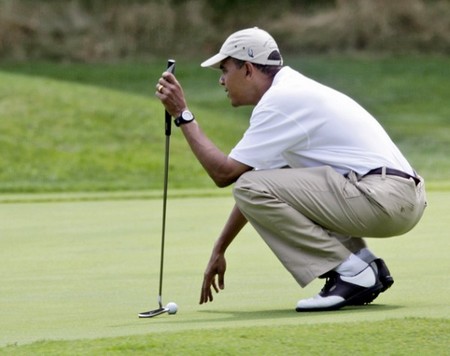When faced with a bank in front of them, most club golfers wrongly assume that the only way to get over it is to use a wedge. But it is not always the easiest and safest way of playing the shot.
Your first choice should be a putter, your second choice a 5, 6 or 7 iron. Your third choice should be a sand wedge. The putter is the easiest and the sand wedge the most difficult of the clubs to play in this situation.
Firstly, look at the grass on the bank ahead of you. If the grass is thick, you may have no alternative but to pitch over it with a sand wedge. If the ground is reasonably bare and the grass fairly short and dry, then the easiest shot is simply a putt. If it looks better than the worst hockey pitch you have ever played on, the ball will probably run through it! Don’t worry if the bank is uneven. The ball will probably be thrown to right and left but will work its way to the top of the bank and over it.
If your ball sits in fluffy grass but the grass on the bank is short, then use a 5, 6 or 7 iron and run the ball up the bank. This is also the correct shot if the ground is bare and the shot looks too long for using your putter.
To run the ball up the bank you need to use a 5, 6 or 7 iron and to tip the club forward like a 4 iron so that it runs low and scuttles up the bank. Hold whichever club you choose in your right hand and tip it forward to the loft of a 4 iron. If less than 40 metres (45 yards) or so, use a putting grip. Use a wide stance and lean to the left so the top of the club points to your navel or just left of it. Keep the shoulders level. Keep the hands leading and think of punching the ball low so that it gets onto the ground and bounces at least twice as it runs up the bank.
The reason for tipping the club forward from its standard loft is to ensure that you hit the ball first and then the ground after it. Don’t just use a 4 iron. Tip the club forward for a ball-ground contact. The 5 iron is often easier to use but the shaft can feel uncomfortably long for women golfers. The 7 iron is more manageable in length but needs to be tipped forward more.
Running a ball with a 5, 6 or 7 iron is particularly useful when the flag is just over the top of the bank. There may be very little landing room for a sand wedge shot and the running shot is easier to control.
You need to consider carefully the way the ball sits. Different lies require different shots. The three shots from a divot hole, an ordinary lie and a tuft of grass require a different approach. Most players wrongly try to putt from the tuft of grass and use a wedge from the divot hole. With the ball sitting in a divot you can only strike the back of the ball.
You can’t find the bottom of the ball with a sand wedge unless you are hitting a longer shot and going to take an even larger divot. If the ball sits in a divot hole, use a putter. The putter will meet the back of the ball. The ball will jump out of the hole and run forwards. Use an ordinary swing with your putter, perhaps using a little more wrist than normal. You’ll be surprised how easily the ball jumps and runs on its way. It can be easier putting from a divot than from a good lie. If the shot looks too long for your putter, then run it with a 5, 6 or 7 iron. If you wrongly use your sand wedge, the swing is much longer than with either of the other two clubs, and you will simply strike the back of the ball and thin it far too far. Only use your sand wedge from a good, tufty lie when you can find the bottom of the ball with ease.
Categories
Advertisements
Recent Articles
 How to Understand Bed Sizes – A Small Guide
How to Understand Bed Sizes – A Small Guide How to Select Some Must Have Kitchen Accessories
How to Select Some Must Have Kitchen Accessories Best Way to Change a Car Tire
Best Way to Change a Car Tire Best Way to Write an Affirmation
Best Way to Write an Affirmation Best Way to Take Charge of Your Financial Life
Best Way to Take Charge of Your Financial Life Best Way to Survive a Party When You Don’t Know Anyone
Best Way to Survive a Party When You Don’t Know Anyone Best Way to Stop Self Sabotaging Yourself
Best Way to Stop Self Sabotaging Yourself Best Way to Start Journal Writing
Best Way to Start Journal Writing Best Way to Speak with a Powerful Voice
Best Way to Speak with a Powerful Voice Best Way to Simplify Your Life
Best Way to Simplify Your Life Best Way to Respond to a Put-Down
Best Way to Respond to a Put-Down Best Way to Reduce Acne Breakouts
Best Way to Reduce Acne Breakouts Best Way to Recover from Dining Disasters
Best Way to Recover from Dining Disasters Best Way to Quit Your Job Gracefully
Best Way to Quit Your Job Gracefully Best Way to Make Your Own Website
Best Way to Make Your Own Website



Leave a Reply